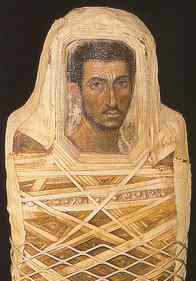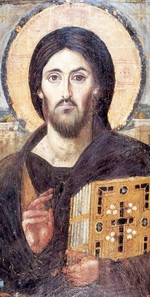




 |
 |
 |
 |
 |
DEVELOPMENT |
ONLINE
PROJECTS |
|||||
|
Some Possible HISTORY of ENCAUSTIC |
|||||||||
Encaustic means : "to burn in" It seems that confusion exists in modern understanding of encaustic and what that really meant in Ancient times. There are a number of approaches in modern artistic practise that can be embraced as encaustic working. Whilst molten application has been strongly adopted in some contemporary sectors there is a growing body of scientific evidence to support the belief that encaustic works from at least some of the Ancient's wall paintings were created by use of a type of wax soap. Check www.encaustic.co for helpful links to various approaches Is Encaustic A Heated Wax Technique Only? The Hot Wax Method - is how we might think of encaustic in its truest sense - that is in using heat as the solvent for beeswax based pigmented wax paints. It is generally agreed that there were three tools used in this type of working. Thin wooden panels were usually the best choice for painting onto with molten wax, although linen was also used. Remember that the funerary portraits were designed to be bound into the head area of the mummy wrappings, so thin flexible wood was better suited than thick rigid boards. The wax would be heated by some means, perhaps over charcoal? Anyway, once molten the pigments might have been blended into a volume of wax and applied to the wood surface by brush. For finer colouring or smaller quantities it might have been more practical to dip a brush into some molten wax then blend this on a heated palette surface with small amounts of pigment, perhaps laid out in bowls so that the brush tip could just be dipped in to collect the right amount of the powder. Looking at the portraits it seems that the main body of colour was applied using the brushes and then afterwards tooled with the hot or cold instruments (named above) to form greater blending, texturing and variety of thickness. There is still much unknown about the original process and discussion continues, research continues, in fact, we are still unsure. The Cold Wax method - Punic Wax - Pliny and Dioscorides, both men of Ancient history, give very similar recipes for Punic Wax. They told of a process where beeswax is boiled in salt sea water then strained through cheese cloth to remove impurities. This was done several times. They then decreed that the wax be left in sun or moonlight for several days to better bleach it. After this the wax needed to be saponified (made soap-like) by adding sodium hydrogen carbonate (Sodium Bicarbonate). This was mixed together and then later, drained again through cheesecloth, rinsed in lukewarm water and finally air dried. It would then probably have been tempered for painting by mixing with other naturally available ingredients: These components when combined into a medium and mixed with pigment certainly produce a workable paint that enables results of very similar visual character to those found in Ancient Roman Egypt. Water Soluble Wax A look at the way in which the Ancients worked: The Mysterious Fayum Portraits Faces from Ancient Egypt Author : EUPHROSYNE DOXIADIS Published by THAMES & HUDSON 1995 ISBN 0-500-23713-1 |
||||||||||
 | In 1997 the British Museum held an exhibition of several hundred exhibits, including many encaustic burial portraits.
|
 |
| Artemidorus - Egyptian Prince - FAYUM WEBSITE In Ancient Egypt it was customary for those who could afford it (or were accorded it) to have a burial portrait made and bound onto the mummified body of the deceased. Some were painted in Tempera but many were done in encaustic wax. At FAYUM many examples were found. Click Artemidorus to go and see some examples. |
 |
Christ Pancrator -
St.Catherine's Monastry Mt Sinai, Egypt This icon is world famous and resides in the icon gallery of the monks at St.Catherine's monastry which is at the foot of Mount Sinai. In this monastry are contained what are held as relics of Moses - the burning bush and Moses well. There is a richly decorated and artisticly full Church of the Transfiguration and then a small but vastly precious icon gallery. This small gallery contains the largest collection of illuminated manuscripts outside of the Vatican. And it managed to escape the iconclast period's destruction of icons and about one third of those surviving icons are to be found here. Read Michael Bossom's story of an unexpected visit to that place on the auspicious date of 12.12.12 |
| This whole site is about what is happening to encaustic wax as a medium for art, creativity, relaxation, therapy, education and more. Much of the approach is for leisure, for hobby and for relaxing therapeutic outcomes. You can look pretty much anywhere to discover something interesting and the site is here to form a resource of information for everyone to browse and use. Our experience of encaustic started in 1986 and has already led many others into a direct exploration and in involvement in this fascinating medium. You could go to this brief article about How to paint with an iron written as a beginners guide to beekeepers not painters! or find out how we got going by clicking on this link which explains a bit about us. |
|